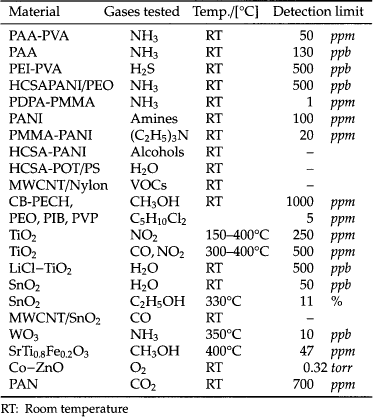Chapter 12
Acoustic Wave Sensors
The basic principles of acoustic wave sensors are described in a separate chapter on sensor types. Here, special applications in context to chemical analysis are summarized.
The first surface acoustic wave (SAW) chemical sensor was described in 1979 (1). Monographs and reviews dealing with this topic are available (2–6). Recent studies using SAW sensors are summarized in Table 12.1.
Table 12.1 Usage of surface acoustic wave sensors
| Sensor Material | Analytes | Reference |
| Poly(pyrrole) | H2 and NO2 | (7) |
| Fluoropolyol | Dimethyl methylphosponate | (8, 9) |
| Poly(vinyl alcohol) | Humidity | (10, 11) |
| Carbowax | 2,4-Dinitrotoluene | (12) |
A series of polymers have been used to detect gases of various kinds. The state of the art has been reviewed (13) and is summarized in Table 12.2.
Table 12.2 Electrospun gas sensors (13)

12.1 Analytes
12.1.1 Hydrogen, Nitrogen dioxide
SAW gas sensors using nanofibers from poly(pyrrole) as the active component were used for the detection of hydrogen and nitrogen dioxide at room temperature. The nanofibers were synthesized by a template-free chemical route.
The polymerization of pyrrole in the presence of FeCl3 as the oxidizing agent was accelerated by the addition of 2,2′-bipyrrole (7). 2,2′-Bipyrrole was synthesized as shown in Figure 12.1.
Figure 12.1 Synthesis of 2,2′-bipyrrole (14)
An average diameter of the nanofibers ...
Get Polymeric Sensors and Actuators now with the O’Reilly learning platform.
O’Reilly members experience books, live events, courses curated by job role, and more from O’Reilly and nearly 200 top publishers.

